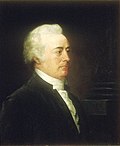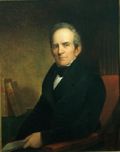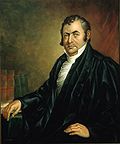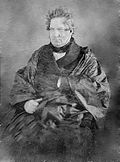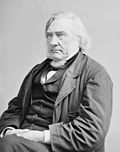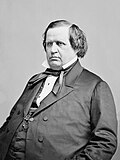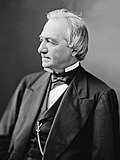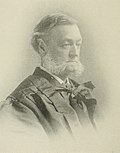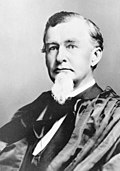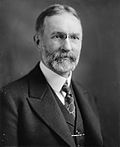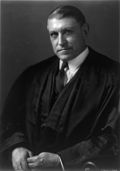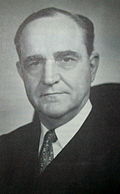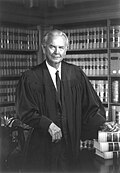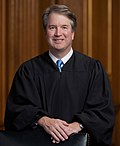Top Qs
Timeline
Chat
Perspective
List of justices of the Supreme Court of the United States
From Wikipedia, the free encyclopedia
Remove ads
The Supreme Court of the United States is the highest-ranking judicial body in the United States. Its membership, as set by the Judiciary Act of 1869, consists of the chief justice of the United States and eight associate justices, any six of whom constitute a quorum.[1][2] Article II, Section 2, Clause 2 of the Constitution grants plenary power to the president of the United States to nominate, and with the advice and consent of the United States Senate, appoint justices to the Supreme Court; justices have life tenure.[3]
Remove ads
Background
Summarize
Perspective
The Supreme Court was created by Article III of the United States Constitution, which stipulates that the "judicial power of the United States, shall be vested in one Supreme Court,"[4] and was organized by the 1st United States Congress. Through the Judiciary Act of 1789, Congress specified the Court's original and appellate jurisdiction, created thirteen judicial districts, and fixed the number of justices at six (one chief justice and five associate justices).[5][6]
Since 1789, Congress has occasionally altered the size of the Supreme Court, historically in response to the country's own expansion in size. An 1801 act would have decreased the Court's size to five members upon its next vacancy. However, an 1802 act negated the effects of the 1801 act upon the Court before any such vacancy occurred, maintaining the Court's size at six members. Later legislation increased its size to seven members in 1807, to nine in 1837, and to ten in 1863. An 1866 act was to have reduced the Court's size from ten members to seven upon its next three vacancies, and two vacancies did occur during this period. However, before a third vacancy occurred, the Judiciary Act of 1869 intervened, restoring the Court's size to nine members, where it has remained ever since.[7]
While the justices of the Supreme Court are appointed for life, many have retired or resigned. Beginning in the early 20th century, many justices who left the Court voluntarily did so by retiring from the Court without leaving the federal judiciary altogether. A retired justice, according to the United States Code, is no longer a member of the Supreme Court, but remains eligible to serve by designation as a judge of a U.S. Court of Appeals or District Court, and many retired justices have served in these capacities. Historically, the average length of service on the Court has been less than 15 years. However, since 1970 the average length of service has increased to about 26 years.[8]
Remove ads
List of justices
Summarize
Perspective
Since the Supreme Court was established in 1789, 116 people have served on the Court. The length of service on the Court for the 107 non-incumbent justices ranges from William O. Douglas's 36 years, 209 days to John Rutledge's 1 year, 18 days as associate justice and, separated by a period of years off the Court, his 138 days as chief justice. As of May 13, 2025, the length of service for the nine incumbent justices ranges from Clarence Thomas's 33 years, 202 days to Ketanji Brown Jackson's 2 years, 317 days. Five individuals, who were confirmed for associate justice, were later appointed chief justice separately: John Rutledge,[a] Edward Douglass White,[b] Charles Evans Hughes,[a] Harlan F. Stone[b] and William Rehnquist.[b] While listed twice, each of them has been assigned only one index number. The justices of the Supreme Court are:[9][10]
Remove ads
Timeline of justices
This graphical timeline depicts the progression of the justices on the U.S. Supreme Court.[9][10] Information regarding each justice's predecessors, successors, and fellow justices, as well as their tenure on the court, can be gleaned (and comparisons between justices drawn) from it. There are no formal names or numbers for the individual seats of the associate justices, which are listed in the table below simply by number. Additionally, the progression of U.S. presidents is shown at the top of the timeline to give a more detailed historical context.

See also
Notes
- State or federal district of residence at the time of appointment. For example, in 1971, Rehnquist was appointed from Arizona, but in 1986, when elevated to chief justice, he was appointed from Virginia.[10]
- The start date given for each justice is the day they took the prescribed judicial oath of office, with the end date being the date of the justice's death, resignation, or retirement.[10]
- While Justice Wilson was the first to take the oath of office, § 1 of the Judiciary Act of 1789 prescribes precedence of the associate justices by the dates their judicial commissions bear. This rule of precedence exists to this day, codified at Title 28, U.S. Code § 4. The commissions of the first four associate justices bear the following dates: Rutledge, Sept. 26, 1789; Cushing, Sept. 27; Wilson, Sept. 29; and Blair, Sept. 30.
- Recess appointment. Note: the date on which the justice took the judicial oath is here used as the date of the beginning of their service, not the date of the recess appointment.
- Was impeached, but not convicted, and remained in office.
- While Willis Van Devanter and Joseph Rucker Lamar were sworn in as associate justice on the same date, their seniority (precedence) on the Supreme Court was determined by the dates borne on their judicial commissions—President Taft issued the judicial commission of Justice Van Devanter on Dec. 16, 1910, bearing that date; the commission of Justice Lamar issued the next day, Dec. 17.
- Although Lewis Powell and William H. Rehnquist were both sworn into office as associate justice on the same day, Powell by law took precedence as the more senior associate justice, his judicial commission bearing the date Dec. 9, 1971; Rehnquist's commission bore the date of Dec. 16, 1971.
Remove ads
References
External links
Wikiwand - on
Seamless Wikipedia browsing. On steroids.
Remove ads


